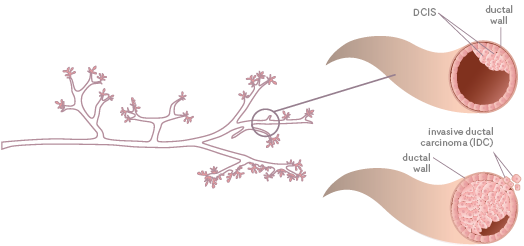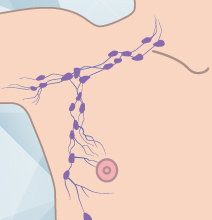Types of breast cancer
Most breast cancers are ductal or lobular carcinomas. This means that they develop from the cells that cover the breast ducts or lobules (the glands that make milk), and sometimes the areola.
Ductal and lobular carcinomas can be invasive (where the cancer cells are able to move, invading other tissues) or in situ (localized or non-invasive).
Carcinomas in situ are not real cancers.
They are tumors that grow inside the breast ducts or lobules, without the ability to invade other parts of the breast. They should still be regularly checked, because they increase the chance of breast cancer.

Learn about the most common male breast cancers:
Ductal Carcinoma In Situ (DCIS)
In DCIS the cancer cells form in the ducts, but do not invade other tissues.
Usually cured just with surgery
Frequency: Accounts for about 10% of male breast cancers
Invasive Ductal Carcinoma (IDC)
The tumor crosses the duct borders, invading other breast tissues
The invasive carcinoma can spread and move to other organs in the body
Frequency: Accounts for about 80% of male breast cancers
Lobular Carcinoma In Situ (LCIS)
LCIS develops in the cells of the breast lobules. It is not a real cancer, in the same way DCIS is not, because it stays confined to the lobules.
It is rare in men, since the male breast has very few (or no) lobules.
Like DCIS, it has high risk of degenerating into breast cancer.
Invasive Lobular Carcinoma (ILC)
ILC is a tumor that appears in the breast/mammary lobule and spreads to other tissues of the breast.
Again it is very rare in men, because of the almost absence of male breast lobules.
Frequency: Around 2% of male breast cancers.
Paget's disease of the breast (or the nipple)
A rare condition of unknown cause that it is often associated with breast cancer, and as such is important to identify.
Symptoms start as a rash in the nipple that extends to areola (the darker circle around it). The skin becomes flakey, thick, or red. The lesion can feel itchy or give a burning sensation, swell or even bleed.
Because of all these symptoms, Paget's disease is often confused with a simple skin condition.
Some women can feel a nodule under the nipple, and this be a sign of invasive cancer. But it is rare, and Paget's disease tends to be linked with non-invasive cancers.
With or without a nodule, any changes in the nipple and/or areola should be immediately reported to your doctor




